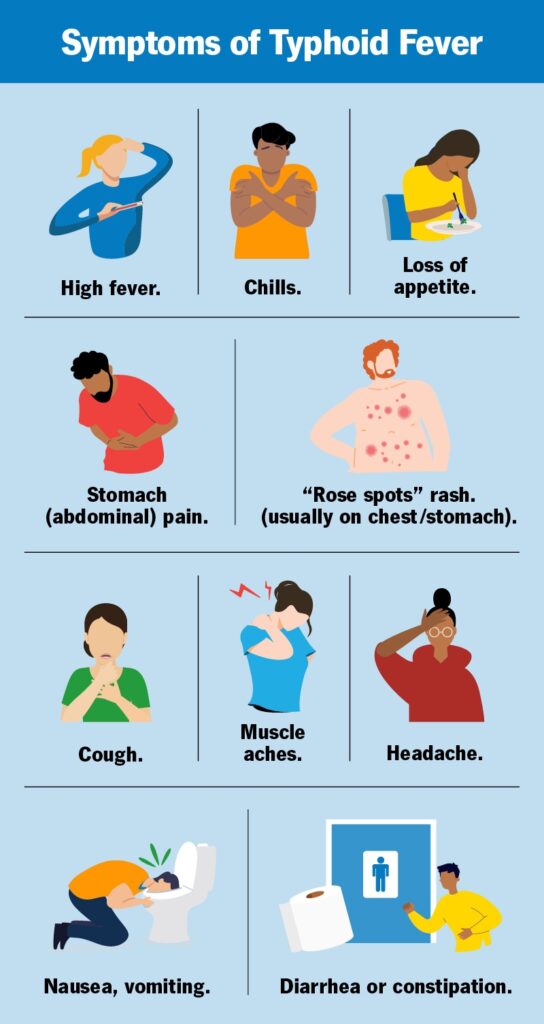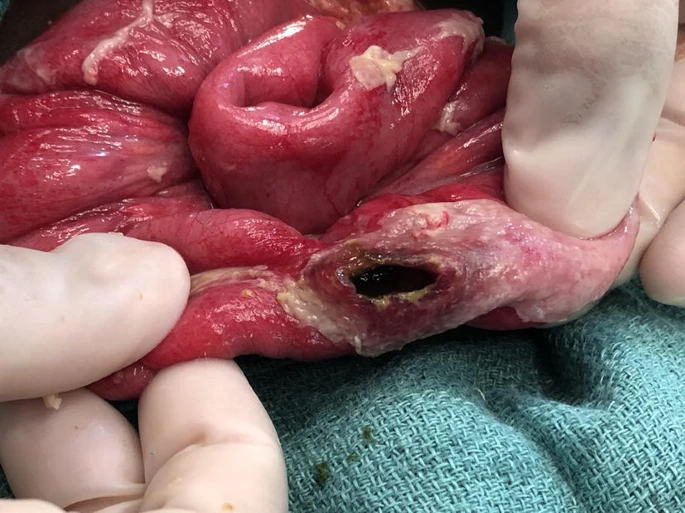One of the reasons why people need to go to the hospital when they are sick is to confirm their diagnosis and get better treatment. The practice of taking antibiotics and antimalarials on a self-prescribed basis has caused resistance to antibiotics in most people.
The worst part of this case is that when the wrong treatment is given, no result is achieved and later it will be predisposed to resistance that will make it difficult to contain the disease when it eventually comes.
This inability to contain the disease can give way to more severe complications of typhoid fever. At that point, it will not only cost you more money to treat it; it will also take more of your time as you will be on hospital admission if you don’t lose your life.
Typhoid fever is endemic in Nigeria due to poor hygiene and inadequate water supply. This is why everyone is likely to have this disease at some point in their life, including some people in urban areas.
Early and adequate treatment is key to avoiding complications such as intestinal perforation. In this post, I will give you a free guide and health tips on how to handle typhoid fever to avoid complications from typhoid sepsis.
Complications from typhoid fever kill faster than the disease itself. I intend to talk about typhoid perforation and typhoid bleeding but before then, let me lay the foundation so that you will understand where the complications are coming from. I believe it will help you get better care each time you suspect that you have the illness. This is about your health. Take a few minutes to go through this health publication.
What is typhoid fever?
Typhoid fever, caused by the bacterium Salmonella serotype Typhi, remains a significant public health concern in many parts of the world, particularly in regions with poor sanitation and limited access to clean water. Nigeria is one of those countries where typhoid fever is causing havoc every day. These bacteria enter the body through the mouth and go to the intestine, where they will multiply and cause you harm.
It comes with almost similar symptoms as malaria and other diseases, making it a bit uneasy to isolate and treat. This is why most patent medical dealers treat both malaria and typhoid as one. When it is poorly treated, it can stay in the body for a longer time and progress to cause more severe complications.
One of the most severe complications of typhoid fever is typhoid perforation, a condition characterized by the perforation of the intestinal wall, leading to leakage of intestinal contents into the abdominal cavity. Typhoid perforation carries a high mortality rate if not promptly diagnosed and treated.
Another complication of typhoid fever is typhoid bleeding. I have decided to cover both complications (typhoid perforation and typhoid bleeding) in separate posts. In this article, I will cover the interventions needed for typhoid fever.
Symptoms of Typhoid Fever:

Typhoid fever typically presents with a gradual onset of symptoms that worsen over time. The manifestations can vary widely among individuals, ranging from mild to severe. Common symptoms include:
- Fever: Sustained high fever, often reaching temperatures of 103–104°F (39–40°C), is a hallmark of typhoid fever. The fever pattern may exhibit a stepwise increase over several days, giving it the characteristic “step ladder” appearance. In some cases, this fever is enough to stop you from your routine activities. Giving antipyretics in this case will only temporarily bring the temperature down.
- Headache and Malaise: Patients commonly experience headaches, generalized weakness, and a feeling of malaise. These symptoms contribute to the overall feeling of unwellness commonly noticed by people with typhoid fever.
- Abdominal Pain: Abdominal discomfort, often described as cramping or tenderness, is a frequent complaint. The pain may localize to the right lower quadrant, mimicking appendicitis in some cases. This is because the organism causing this disease affects more of the ileum, leading to inflammation.
- Gastrointestinal Symptoms: Typhoid fever can affect the gastrointestinal tract, leading to symptoms such as nausea, vomiting, diarrhea, or constipation. Diarrhea, when present, is typically non-bloody but may progress to become more severe.
- Rash: A rose-colored rash, known as “rose spots,” may appear on the trunk of the body. These maculopapular lesions are transient and may be observed in approximately one-third of patients. However, it is not routine to notice a rash in every patient with typhoid fever.
- Respiratory Symptoms: Cough and sore throat may occur, although they are less common than other symptoms. It is important to note that when the illness has spread, it can disseminate to other body parts, including the lungs where it can produce effects like coughing or cacatarrh, the case may be.
- Neurological Manifestations: In severe cases, patients may develop neurological complications such as confusion, delirium, or even seizures. These symptoms necessitate urgent medical attention. This is mostly in the later part of the illness. There can also be a neurological side to it, especially in children, where the illness can cause some form of seizure if not properly handled.
Investigations for Typhoid Fever:
Diagnosing typhoid fever relies on a combination of clinical assessment, laboratory tests, and imaging studies. Your doctor may request the following investigations to help him arrive at a diagnosis:
- Blood Culture: The gold standard for diagnosing typhoid fever is isolating S. typhi from blood cultures. Multiple blood samples collected over several days may be necessary to enhance diagnostic sensitivity, as bacteremia can be intermittent. This test is mostly done within the first week of the onset of the symptoms.
- Stool Culture: While less sensitive than blood culture, stool culture can be valuable, particularly in cases where blood cultures are negative. S. typhi can be shed in feces, contributing to the transmission of the infection. This test is most reliable within the second week of the onset of suspected typhoid fever.
- Urine test: A urine test remains one of the last resort investigations carried out to rule out the presence of salmonella as the causative bacteria.
- Widal Test: Despite its limitations, the Widal test is often used in resource-limited settings for rapid serological diagnosis. It detects antibodies against S. typhi antigens, including O and H antigens. However, interpretation can be challenging due to cross-reactivity with other Salmonella serotypes and variations in baseline antibody titers. Due to reliability doubts, this test is mostly limited to areas where there is no other hope.
- Imaging Studies: In severe cases or those with suspected complications, imaging studies such as abdominal ultrasound or computed tomography (CT) may be warranted to evaluate for features like intestinal perforation, abscess formation, or other complications.
Treatment of Typhoid Fever:
When your doctor has made the diagnosis of typhoid fever using the information he got from you and the result of the investigations you have done, he will commence treatment to ensure that you recover quickly. Such treatment of typhoid fever involves effective antimicrobial therapy, supportive care, and, in some cases, hospitalization. Key aspects of treatment include:
- Antibiotic Therapy: Antibiotics are the cornerstone of typhoid fever treatment. First-line agents include fluoroquinolones (e.g., ciprofloxacin) and third-generation cephalosporins (e.g., ceftriaxone). One of the above can also be used in combination with Metronidazole, which is in the class of drugs called Nitroimidazole. However, increasing antimicrobial resistance necessitates periodic reassessment of treatment recommendations, particularly in regions with high resistance rates.
- Supportive Care: Adequate hydration and nutrition are essential components of supportive care. Patients with significant gastrointestinal symptoms may require intravenous fluids to maintain fluid and electrolyte balance. Nutritional supplementation may be necessary, especially in individuals with prolonged illness or malnutrition. In some cases, you may be required to stay without taking food directly through your mouth; rather, what you will be having is fluid through intravenous access.
- Isolation and Infection Control: Patients diagnosed with typhoid fever should be educated about proper hygiene practices to minimize the risk of transmission to others. In healthcare settings, standard precautions should be implemented to prevent nosocomial spread.
- Monitoring and Complication Management: Close monitoring of clinical status, including vital signs, fluid intake and output, and laboratory parameters, is essential. Complications such as intestinal perforation, gastrointestinal bleeding, or neurological sequelae require prompt recognition and appropriate management, which may include surgical intervention in select cases.
- Vaccination: immunization has been found to contribute greatly to the end of this infectious disease. The typhoid vaccine is made for people aged 2 years and older. It is also mostly important for people who live in countries where typhoid fever is rare. It is therefore advised that those living in less typhoid fever-prone regions should get themselves immunized before embarking on such a journey.
Typhoid Vaccines
Typhoid vaccines are designed to provide immunity against Salmonella typhi, the bacterium responsible for causing typhoid fever. These vaccines stimulate the body’s immune system to produce antibodies, which then recognize and neutralize the bacteria if exposed to them in the future. Essentially, they train the immune system to recognize and fight off the typhoid bacteria before it can cause illness.
Types of Typhoid Vaccines:
- Ty21a Oral Vaccine: This vaccine consists of live, weakened strains of Salmonella Typhi bacteria. Administered orally in the form of capsules. Requires a series of doses, usually taken over a week or so. Protects against typhoid fever for several years. Suitable for individuals aged six years and older.
- Vi Capsular Polysaccharide Vaccine: Contains a purified polysaccharide from the Salmonella Typhi bacteria. Administered via injection. Requires a single dose. Protects for around two years. Suitable for individuals aged two years and older.
- Vi Conjugate Vaccine: Similar to the Vi capsular polysaccharide vaccine but with an added protein. Provides longer-lasting immunity compared to the Vi capsular polysaccharide vaccine. Suitable for individuals aged six months and older. Administered via injection. Requires a single dose.
How Do Typhoid Vaccines Work?
Typhoid vaccines work by mimicking the presence of the Salmonella typhi bacterium in the body, without causing illness. When the vaccine is administered, the immune system recognizes the components of the bacterium as foreign invaders and mounts a defense response. This response involves the production of antibodies specific to Salmonella typhi as well as the activation of immune cells that can destroy the bacteria.
In the event of future exposure to the actual Salmonella typhi bacterium, the immune system is primed and ready to mount a rapid and effective response. The antibodies produced in response to the vaccine quickly recognize and neutralize the bacteria, preventing infection and the onset of typhoid fever.
Before taking this vaccine, it is important to consult your physician for appropriate advice on the one that is best for you and to also confirm if you should take it. Your doctor’s advice will be based on the information he can gather from you. It could be about your travel history and also your health history, especially as regards traveling to countries where the disease is prevalent.
Effectiveness of Typhoid Vaccines:
Typhoid vaccines are highly effective in preventing typhoid fever, particularly in individuals living in or traveling to areas where the disease is endemic. Studies have demonstrated that vaccinated individuals have a significantly reduced risk of contracting typhoid fever compared to unvaccinated individuals.
However, like all vaccines, the effectiveness of typhoid vaccines may vary depending on factors such as the individual’s immune response, the type of vaccine used, and adherence to the recommended vaccination schedule. Additionally, no vaccine provides 100% protection, so it’s still important to practice good hygiene and food safety measures, especially when traveling to areas with a high risk of typhoid fever.
Preventive Measures Against Typhoid Fever:
In addition to vaccination, several preventive measures can help reduce the risk of typhoid fever:
- Safe Food and Water Practices: Drink only bottled or boiled water, especially in areas with questionable water quality. Avoid consuming raw or undercooked foods, particularly shellfish, fruits, and vegetables, that may have been washed in contaminated water. Choose foods that are freshly prepared and served hot. Here is the major challenge with developing countries: they may have enough water supply within their urban areas but the rural areas will almost be starved of good water supply. If water is not enough, it will impact the level of hygiene within the communities.
- Good Hygiene Practices: Wash hands frequently with soap and water, especially before eating or preparing food and after using the bathroom. Use hand sanitizers containing at least 60% alcohol if soap and water are not available. The reason why emphasis is placed on handwashing when this disease is involved is because it is primarily transmitted through what enters the mouth. If you can constantly ensure good hygiene, then you will have less to worry about your safety.
- Sanitation and Waste Management: Use proper sanitation facilities, such as toilets and latrines, to prevent the contamination of water sources with fecal matter. Indiscriminate disposal of waste has been seen as a major contributor to the spread of this disease. therefore, it is important for those who don’t have an effective waste disposal system to adopt a better one now.
- Health Education and Awareness: Educate communities about the importance of vaccination, safe food and water practices, and good hygiene habits. Dispose of waste properly and avoid open defecation. Raise awareness about the symptoms of typhoid fever and encourage early detection and treatment. Regardless of how prevalent this disease may be in most countries, it is important to note that communities that practice good hygiene are rarely attacked by the outbreak of the above illness.
Conclusion:
Typhoid fever continues to be a major health concern, especially in areas with inadequate sanitation and healthcare infrastructure, such as Nigeria. Early recognition of symptoms, timely diagnostic evaluation, and the initiation of appropriate treatment are critical for reducing the morbidity and mortality associated with this illness.
It is important to always put up a strong fight against this illness since it can predispose to intestinal perforation and gastrointestinal bleeding when it is not adequately treated.
Continued efforts to improve sanitation, access to clean water, and vaccination coverage are essential components of comprehensive typhoid fever control strategies. Through concerted action and collaborative initiatives, we can strive towards the goal of eliminating this preventable and treatable infectious disease.

